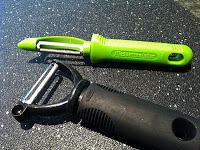Today I’m starting a new series of posts that will offer a primer on culinary basics. In my first two posts, I’ll share what I know about basic kitchen gear; in upcoming posts, I plan to explore pantry essentials and fundamental cooking techniques. I hope you enjoy this (temporary) departure from recipes and that you’ll find this information interesting and useful. Of course, your ideas and suggestions are always welcome….
Often, I’m asked by friends to offer guidance regarding which tools and equipment are important to have to properly outfit their kitchens. Having spent several years working at Williams-Sonoma and Sur La Table, I became pretty well-versed on the subject. I learned a thing or two about pots and pans, knives, tools, and the latest gadgets and thought it would be fun to share with you–which ones I think are necessary, and which are just helpful extras to have on hand in a functioning kitchen. As you can see, thanks to a generous employee discount, I was able to build a pretty sizeable collection of stuff for myself. Quite honestly, even with all the cooking I do, I don’t really use it all. But there are some essential pieces I wouldn’t live without. I’ll do my best to explain the hows and what-fors, and I encourage you to ask any questions you might have using the comments section at the end of this post.
Part One: Kitchen Tools
In culinary school, we learned that you can do a lot with less, requiring only a few tools: a small paring knife, a chef’s knife, a handful of pots, pans, and mixing bowls. The theory is that once you’ve mastered your technique, most specifically, knife skills, you can do any job in the kitchen. But the reality is that most of us don’t have those skills down pat and we need specific utensils for specific jobs. So, without further ado, here are my suggested kitchen essentials (and a few extra indulgences):
Knives
When choosing a good quality knife, it’s very important to hold it in your hand. The handle should fit well in your palm with a comfortable grip and should have nice weight. I prefer handcrafted Japanese knives by Shun: their blades, made of 16 layers of high carbon steel, are easy to keep sharp, and their handles, made of Pakka wood, have a “D” shape which feels comfortable to hold.

Essential Knives to Own (top to bottom):
8″ or 10″ Chef’s Knife – All-Purpose Chopping
6″ or 8″ Santoku Knife – Dicing/Chopping
6″ Utility Knife (preferably serrated) – Slicing
6″ Santoku Knife – Mincing
3″ Paring Knife – Peeling, Small Tasks

Some Extras to Have (left to right):
Good Quality Kitchen Shears
Boning Knife – Butchering, Flexible Blade
9″ Serrated Bread Knife – Slicing
Carving Fork
9″ Carving Knife – Carving and Slicing
Sharpening Steel – Keeps Blades Sharp
…and a Wooden Block to keep them all in.
Tools
Well-worn and well-loved, my wooden spoons and silicone spatulas are the most used items in my kitchen. I love the flat wooden slotted spatula for sauteing, the round spoons for stirring. The silicone spatulas (heat resistant to 500 degrees) are my go-tos for eggs and delicate jobs; my orange “spoonula” is wonderful for baking and scraping.
These two tools are put to work on a daily basis. In my garlic press, I can place a whole clove of unpeeled garlic and press out perfectly mashed garlic meat, juice and all. Place a half lemon or lime, cut side down, in this big yellow lemon juicer, bring the handles together, and this ingenuous tool will squeeze out every last drop of juice, while keeping the pits to itself.

Tongs are essential in any kitchen–they are like another set of hands when you don’t want to stick yours in a scalding pan. Great to have 2 sizes: long and short; silicone tipped ones are nice too.


And where would we be if we couldn’t measure anything? I often use a pinch of this or that, but sometimes you just have to crack out the measuring spoons and cups for dry ingredients.

To measure out liquids, I love my Pyrex glass measuring cups–they’re great for whisking up salad dressings, and the 4 cup size is wonderful for big jobs and baking.
A Few Extras
The following group of utensils are not really necessary but they certainly can come in handy. And, since none of them are really expensive, it’s probably more a matter of whether or not you have room for them…

These two tools look pretty similar but actually serve very different purposes. The bamboo handled spider skimmer is a whiz at scooping up when you’re blanching or deep-frying; the stainless mesh skimmer perfectly skims the foam from a boiling stock.
This pair, honestly, hang out in the back of my drawer most of the time. But when I need them, there’s no substitute. The wire masher on the top comes in handy to mash avocados or potatoes when I’m in a rush. The meat pounder thins chicken breasts for paillard, or does double duty when I’m making smashed potatoes.
Finally, a couple of indulgences. My potato ricer can, quite frankly, be a pain in the neck to use, but there’s nothing like the fluffy, perfectly mashed potatoes it yields. And when you really want to get paper thin slices for a cucumber salad, this Japanese mandoline, known as a benriner, works beautifully–just be sure to use the guard to save your fingers. Oh, and you can justify its purchase by comparing it to that $200 fancy French model that’s a lot more complicated to use.
Next in this Series: The Well-Equipped Cupboard












Great thoughts you got there, believe I may possibly try just some of it throughout my daily life
Cooking Equipment
What a great idea and so well presented. I am sure that all the info will be quite helpful.
I love it! Now I just want to shop!
~Liz
http://www.eatallthethings.com